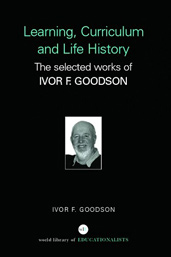Learning, Curriculum and Life Politics: the selected works of Ivor F. Goodson
Becoming a School Subject
In these schools, without full-fledged academic status, the subject's position as an established part of the curriculum remained uncertain. As a Rochester headmaster noted, 'the over-crowding in the school timetable makes it impossible to give more than one and at most two lessons per week in geography'. In the elementary schools geography was rapidly seen as affording utilitarian and pedagogic possibilities in the education of the children of working people. Hence the take-up of the subject grew considerably in the period following the 1870 Education Act. In 1875 'elementary geography' was added to the main list of class subjects examined in elementary schools.
Given the limited base in the elementary and secondary school sector the promoters of geography began to draw up plans for a subject association. Hence in 1893 the Geographical Association was founded 'to further the knowledge of geography and the teaching of geography in all categories of educational institutions from preparatory school to university in the United Kingdom and abroad'. The formation of the Association in 1893 was extremely well-timed and it rapidly began to operate as a vocal lobby for the subject. Two years later the Bryce Commission reported and its recommendations were built into the 1902 Education Act. Further the 1904 Secondary Regulations effectively defined the traditional subjects to be offered in secondary schools; geography's inclusion in the regulations was a major staging-post in its acceptance and recognition and in the broad-based take-up of external examinations in geography in secondary schools. The emergence of external examinations as a defining factor in secondary curricula around 1917 is clearly reflected in the sharp increase in the Association's membership around this date. At this stage geography was included in many Examination Board regulations both at School Certificate and Higher School Certificate as a main subject. Certain Boards, however, included geography only as a 'subsidiary subject'.
For those teachers involved in promoting geography the founding of a subject association was only a first stage in launching the subject; what was also required was an overall plan aimed at establishing the subject in the various educational sectors mentioned in the constitution. At a discussion on geographical education at the British Association in September 1903, MacKinder outlined a four-point strategy for establishing the subject:
Firstly, we should encourage university schools of geography, where geographers can be made...
Secondly, we must persuade at any rate some secondary schools to place the geographical teaching of the whole school in the hands of one geographically trained master...
Thirdly, we must thrash out by discussion and experiment what is the best progressive method for common acceptation and upon that method we must base out scheme of examination.
Lastly, the examination papers must be set by practical geography teachers.
- Bird, C. (1901) 'Limitations and possibilities of geographical teaching in day schools', The Geographical Teacher, 1.
- Manifesto of Geographical Association printed on the inside cover of all copies of Geography.
- MacKinder, H.J. (1903) Report of the Discussion on Geographical Education, pp. 95-101.
